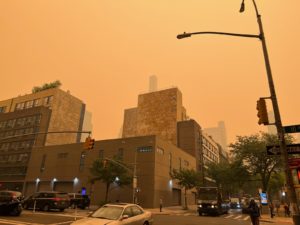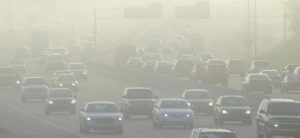
Meteorologists are predicting that we (in the US and Canada) will be experiencing more hazardous air quality days in the coming months and years due to wildfire smoke. An excellent resource for monitoring the air quality where you live is AirNow.gov. It has both current air quality and forecasts.
The NY Times currently has interactive air quality maps, which are tracking the wildfires from Canada.
Smoke is air pollution, whether it's from wildfires, cigarettes, or vehicles. It's not just our lungs and internal organs that suffer from smoke with particles smaller than 2.5 microns. (For comparison: A human hair is at least about 20 microns in diameter.) The particles travel from the lungs through our bloodstream to the organs. But our skin also suffers. It causes flares of inflammatory skin diseases such as eczema, atopic dermatitis, and psoriasis, and increases wrinkles and age spots.
Air pollution is dangerous to everyone!
Some health effects of air pollution: Harm to the lung and airways, damage to most organ systems of the body, lung cancer, COPD deaths, heart disease deaths, stroke deaths, bladder cancer, childhood leukemia, poorer lung development in children, lung impairment in adults, reduced cognitive function, increased risk of dementia, diabetes, effects on immune system, allergic rhinitis, structural changes in the brain, inflammation, and with high levels of smaller than 2.5 μm particles can have delayed psychomotor development and lower child intelligence. And the list goes on!
Do go and check out AirNow.gov and all the links on the site, including an interactive fire and smoke map. Stay indoors (as much as possible) with the windows shut on "unhealthy, very unhealthy, or hazardous" air quality days. Consider wearing masks outdoors and using an air purifier indoors on those days.


 It has long been known that children living in congested cities have higher rates of asthma. All those vehicles, all that pollution. A recent
It has long been known that children living in congested cities have higher rates of asthma. All those vehicles, all that pollution. A recent 
 Which cities in the US have the worst forms of air pollution? Los Angeles remains the city with the worst ozone pollution in the nation. Fairbanks, Alaska is currently the metropolitan area with the worst short-term particle pollution for the first time. And Bakersfield, California returned as the most polluted for year-round particle pollution (for a second year in a row).
Which cities in the US have the worst forms of air pollution? Los Angeles remains the city with the worst ozone pollution in the nation. Fairbanks, Alaska is currently the metropolitan area with the worst short-term particle pollution for the first time. And Bakersfield, California returned as the most polluted for year-round particle pollution (for a second year in a row). High heat is not good for a developing baby during pregnancy. And neither is air pollution. A just published
High heat is not good for a developing baby during pregnancy. And neither is air pollution. A just published